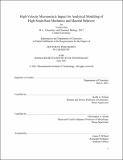High-Velocity Microparticle Impact for Analytical Modelling of High-Strain-Rate Mechanics and Material Behavior
Author(s)
Sun, Yuchen
DownloadThesis PDF (5.873Mb)
Advisor
Nelson, Keith A.
Schuh, Christopher A.
Terms of use
Metadata
Show full item recordAbstract
A recent optical technique for conducting and observing high-velocity micron-scale impacts against various materials is the focus of this work. This technique, the laser-induced particle impact test (LIPIT), is capable of accelerating microparticles to supersonic velocities to achieve strain-rates up to 108 s-1. The platform also provides in situ observations of the impact to allow for quantification of the particle trajectories before and after collision. This work first details the experimental capabilities and limitations. The majority is then spent presenting and discussing the methods of material characterization permitted by the LIPIT platform across various material systems, often involve analytical modelling, post-impact microscopy, and a plethora of complementary techniques. Two major systems discussed are elastomers and metals.
For elastomers, the LIPIT provides a high-strain-rate characterization that is first compared to two low-strain-rate techniques. These results are contextualized through chemical characterization of the elastomers using solid state nuclear magnetic resonance. Temperature dependent impact measurements are then compared with dielectric spectroscopy results to link the impact behavior with the glassy transition.
For metals, high-velocity impacts are performed and characterized using in situ observations, post-impact microscopy, and analytical modelling. Observations of a jetting phenomenon in both in situ and post impact imaging are correlated to divergence from a power-law behavior to reveal a new regime of ‘divergent’ behavior. This regime is further explored in the context of oblique impacts to reveal more interesting impact behavior.
Date issued
2021-06Department
Massachusetts Institute of Technology. Department of ChemistryPublisher
Massachusetts Institute of Technology